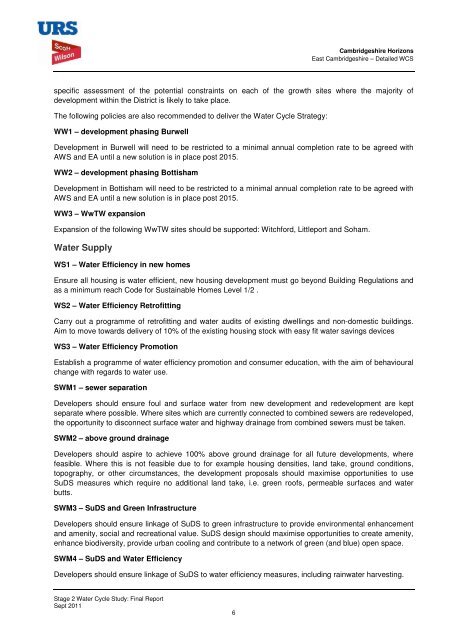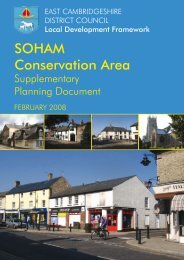East Cambridgeshire District Council Water Cycle Study Detailed ...
East Cambridgeshire District Council Water Cycle Study Detailed ...
East Cambridgeshire District Council Water Cycle Study Detailed ...
Create successful ePaper yourself
Turn your PDF publications into a flip-book with our unique Google optimized e-Paper software.
Stage 2 <strong>Water</strong> <strong>Cycle</strong> <strong>Study</strong>: Final Report<br />
Sept 2011<br />
6<br />
<strong>Cambridgeshire</strong> Horizons<br />
<strong>East</strong> <strong>Cambridgeshire</strong> – <strong>Detailed</strong> WCS<br />
specific assessment of the potential constraints on each of the growth sites where the majority of<br />
development within the <strong>District</strong> is likely to take place.<br />
The following policies are also recommended to deliver the <strong>Water</strong> <strong>Cycle</strong> Strategy:<br />
WW1 – development phasing Burwell<br />
Development in Burwell will need to be restricted to a minimal annual completion rate to be agreed with<br />
AWS and EA until a new solution is in place post 2015.<br />
WW2 – development phasing Bottisham<br />
Development in Bottisham will need to be restricted to a minimal annual completion rate to be agreed with<br />
AWS and EA until a new solution is in place post 2015.<br />
WW3 – WwTW expansion<br />
Expansion of the following WwTW sites should be supported: Witchford, Littleport and Soham.<br />
<strong>Water</strong> Supply<br />
WS1 – <strong>Water</strong> Efficiency in new homes<br />
Ensure all housing is water efficient, new housing development must go beyond Building Regulations and<br />
as a minimum reach Code for Sustainable Homes Level 1/2 .<br />
WS2 – <strong>Water</strong> Efficiency Retrofitting<br />
Carry out a programme of retrofitting and water audits of existing dwellings and non-domestic buildings.<br />
Aim to move towards delivery of 10% of the existing housing stock with easy fit water savings devices<br />
WS3 – <strong>Water</strong> Efficiency Promotion<br />
Establish a programme of water efficiency promotion and consumer education, with the aim of behavioural<br />
change with regards to water use.<br />
SWM1 – sewer separation<br />
Developers should ensure foul and surface water from new development and redevelopment are kept<br />
separate where possible. Where sites which are currently connected to combined sewers are redeveloped,<br />
the opportunity to disconnect surface water and highway drainage from combined sewers must be taken.<br />
SWM2 – above ground drainage<br />
Developers should aspire to achieve 100% above ground drainage for all future developments, where<br />
feasible. Where this is not feasible due to for example housing densities, land take, ground conditions,<br />
topography, or other circumstances, the development proposals should maximise opportunities to use<br />
SuDS measures which require no additional land take, i.e. green roofs, permeable surfaces and water<br />
butts.<br />
SWM3 – SuDS and Green Infrastructure<br />
Developers should ensure linkage of SuDS to green infrastructure to provide environmental enhancement<br />
and amenity, social and recreational value. SuDS design should maximise opportunities to create amenity,<br />
enhance biodiversity, provide urban cooling and contribute to a network of green (and blue) open space.<br />
SWM4 – SuDS and <strong>Water</strong> Efficiency<br />
Developers should ensure linkage of SuDS to water efficiency measures, including rainwater harvesting.






